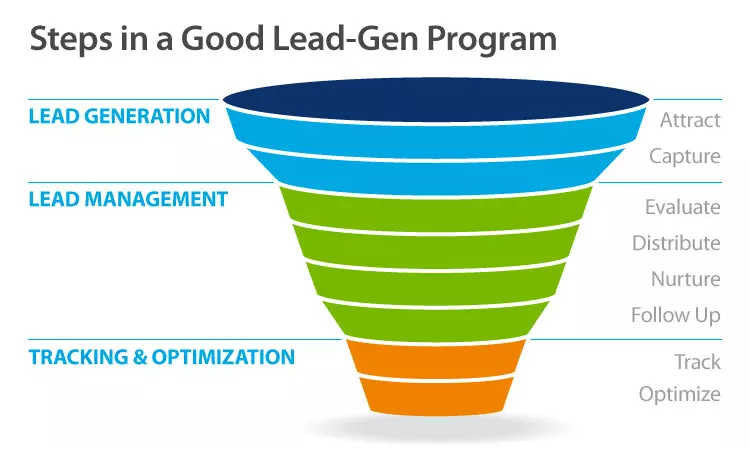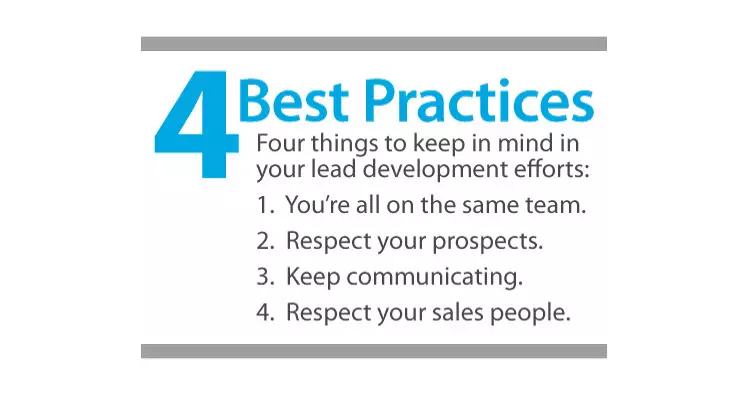Key Steps in Producing Quality B2B Leads

Producing high-quality leads that turn into revenue (relatively) quickly is one of the most important functions in B2B marketing.
Producing high-quality leads that turn into revenue (relatively) quickly is one of the most important functions in B2B marketing.
It will win you friends in the sales department, not to mention the C-suite. It will enable your marketing organization to be viewed less as a cost center and more as a viable part of the revenue team.
For most clients, it is the single most important measure of success of their marketing efforts: How many leads were handed over to sales?
There are three key high-level activities B2B companies should follow to produce leads:
- First, there is lead generation, or the process of getting prospects interested enough to ask for more information. The outcome of the lead-generation process is a Marketing Qualified Lead, or MQL.
- Second, there is lead management, which are the steps you follow to turn that MQL into a Sales Qualified Lead, or SQL.
- And finally, there is the tracking and optimization of the process, where outcomes are measured and the return on investment – in both marketing and sales – can be evaluated.
Within each of these steps are several specialized functions, each with a wide variety of proponents.

Lead Generation
The entire marketing communications effort in some companies would be considered part of the lead generation process. In most programs today, prospects are attracted by ads, public relations, social media activity or e-mail, and are sent to a company’s website.
There, they are provided information designed to pique their interest and get them to ask for more information – something of value that is not available to the general public, like a download, a white paper, a calculator.
Some advanced web content management systems even do “scoring,” assigning a value to users as they go through levels of content, allowing you to extend offers to those who seem most promising.
The second part of the lead-gen process is capturing a prospect’s contact information, so that you can continue to communicate with them. These are Marketing Qualified Leads, or MQLs.
The MQLs then go into the lead management stage, where they are evaluated and passed on to sales when they are ready.
Lead Management
Lead management has four distinct parts:
- Evaluation. While we mentioned scoring in the lead generation stage through the web content management system, it happens most often after a Marketing Qualified Lead is created. In addition to website behavior or expressed interest, systems can compare the prospects’ information to all kinds of additional data like Dun & Bradstreet ratings, SIC codes or internally generated prospect lists. The goal is to make sure an MQL is a serious prospect, not a competitor, college student or information collector, before forwarding to sales.
- Nurturing. This stage simply formalizes the understanding that MQLs are not SQLs. In other words, not everyone who requests more information is sales-ready. So the nurturing step allows your company to keep communicating with an MQL, until they’re ready for a sales call. This step, in particular, has been revolutionized by marketing automation technology that automates the steps you would take to cultivate a lead.
- Distribution. Although it might seem fairly simple to send a lead to sales, there have been many instances where distribution can be a stumbling block. Getting your web content management system to talk to your customer relationship management (CRM) system can require IT involvement. And additional complications can occur when you are selling through distribution, especially when there are not exclusive territories.
- Follow-up. Studies from Forbes and MarketingSherpa indicate that only about 27 percent of marketing leads are ever contacted by sales. The reasons vary, of course, but no matter what the specifics, the low number simply documents the lack of coordination between marketing and sales.
Tracking and Optimization
The last, and perhaps the most important, part of the process is tracking and optimization. At the very least, marketing should be supplied with the classification sales gives to the prospect, depending on what selling system is used. Best of all would be the disposition and sales totals, if applicable.
While it may require some additional time for sales to provide that kind of information, the tracking information is absolutely essential if the process is to be optimized and improved. The optimization process involves using analytics, usually from a web analytics program, to measure the results from various elements of the program, then make changes to improve the outcome.

Four Best Practices
Four things to keep in mind in your lead development efforts:
- You’re all on the same team. Communicate with other functions, especially sales, and make sure you’re on the same page.
- Respect your prospects. Only ask for the information you need – your web forms will be most effective if they are four fields or less. And don’t ask for the same information twice.
- Keep communicating. Develop a regular process of communicating with prospects and customers. Given the long selling cycles in some industries, conversion of a prospect to a customer could take several years. So a lead nurturing program could be highly beneficial in the long run.
- Respect your sales people. Don’t waste time (and discredit the process) by sending out unqualified leads.
Sign Up for our Newsletter - Get agency updates, industry trends and valuable resources delivered directly to you.
Godfrey Team
Godfrey helps complex B2B industries tell their stories in ways that delight their customers.




